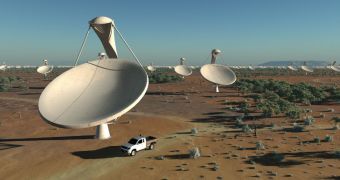Officials at IBM announced yesterday, April 1, that the company was awarded a $42 million contract for processing the data obtained by the Square Kilometer Array (SKA). This will be the most sensitive radio observatory ever developed, and will require enormous amounts of computer processing power.
The telescope's main features are a collecting area of about 1 square kilometer and a sensitivity level about 50 times higher than that of any existing devices of the same class. In order to operate properly, it will need high-performance central computing engines.
Additionally, scientists estimate that the project will require the creation of long-haul links with a capacity greater than the current global Internet traffic. This is the only way to ensure that the instrument will be used at full potential.
SKA will feature receiving stations spread out over a 3,000-kilometer diameter, around a central command center. At this point, plans are to build the telescope in either South Africa, or Australia and New Zealand. Around €1.5 billion have already been reserved for the project .
The actual construction efforts will begin in 2016, and the first phase of the project will conclude by 2019. Managers hope to achieve full functionality by no later than 2024. Beyond that time, SKA will be used to probe the deepest mysteries of the Universe, including its origins.
IBM officials admit that developing and operating the exa-scale (the next step from the peta-scale) computer systems needed for the SKA project will be a challenge. The company will need to develop a series of innovative technologies to allow for the full maturation of this enormous endeavor.
According to the new contract, the supercomputers IBM will build for SKA need to be able to read, store and analyze as much as one exabyte of data daily, which is about twice as much as the entire amount of information currently being produced each day on the Internet, Venture Beat reports.
In order to figure out what these high-performance computers will look like, IBM and ASTRON (the Netherlands Foundation for Research in Astronomy) will collaborate under the Dome project, which will span about 5 years. Achieving energy-efficient exa-scale computing is the main goal here.
“To detect the signals, you really need a good antenna. It would be the equivalent of 3 million TV antennae dishes. This will be a unique instrument. Nothing else can do this kind of science,” IBM expert and SKA data motion architect, Ronale Luitjen, explains.
“This is Big Data Analytics to the extreme. With Dome we will embark on one of the most data-intensive science projects ever planned, which will eventually have much broader applications beyond radio astronomy research,” IBM research scientist Ton Engbersen concludes.

 14 DAY TRIAL //
14 DAY TRIAL //